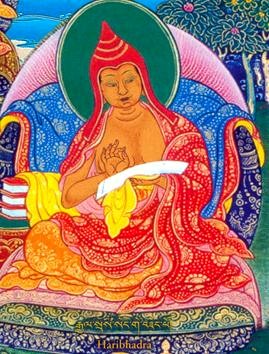Haribhadra: Difference between revisions
Jump to navigation
Jump to search
No edit summary |
mNo edit summary |
||
| Line 1: | Line 1: | ||
[[Image:Haribhadra.JPG|frame|'''Haribhadra''']] | [[Image:Haribhadra.JPG|frame|'''Haribhadra''']] | ||
'''Haribhadra''' (Tib. ''Senge Zangpo'', [[Wyl.]] ''seng ge bzang po'') (late 8th C.) was a great [[pandita]] and master of the [[prajnaparamita]] teachings. He received instructions directly from [[Maitreya]] and composed the ''[[Sphutartha]]'', which is the most celebrated commentary on Maitreya's ''[[Abhisamayalankara]]''. [[Taranatha]] says he was a disciple of [[Shantarakshita]]. He was a teacher of [[Buddhajñanapada]]. | '''Haribhadra''' (Tib. [[སེང་གེ་བཟང་པོ་]], ''Senge Zangpo'', [[Wyl.]] ''seng ge bzang po'') (late 8th C.) was a great [[pandita]] and master of the [[prajnaparamita]] teachings. He received instructions directly from [[Maitreya]] and composed the ''[[Sphutartha]]'', which is the most celebrated commentary on Maitreya's ''[[Abhisamayalankara]]''. [[Taranatha]] says he was a disciple of [[Shantarakshita]]. He was a teacher of [[Buddhajñanapada]]. | ||
==Writings== | ==Writings== | ||
Revision as of 14:46, 1 February 2011

Haribhadra (Tib. སེང་གེ་བཟང་པོ་, Senge Zangpo, Wyl. seng ge bzang po) (late 8th C.) was a great pandita and master of the prajnaparamita teachings. He received instructions directly from Maitreya and composed the Sphutartha, which is the most celebrated commentary on Maitreya's Abhisamayalankara. Taranatha says he was a disciple of Shantarakshita. He was a teacher of Buddhajñanapada.
Writings
- Śāstravṛtti (popularly known as the Sphutartha)
- Light on the Ornament (Skt. Abhisamayālaṃkārālokā), a commentary on the Sutra in Eight Thousand Lines
- Easy-to-Comprehend Commentary on the Difficult Points of the Verse Summary
- Eight Chapters on the 25,000
Further Reading
- David Seyfort Ruegg, The Literature of the Madhyamaka School of Philosophy in India, Wiesbaden: Harrassowitz, 1981, pp. 101-103
- Lobsang N. Tsonawa, Indian Buddhist Pandits from The Jewel Garland of Buddhist History, Dharamsala: Library of Tibetan Works and Archives, 1985.